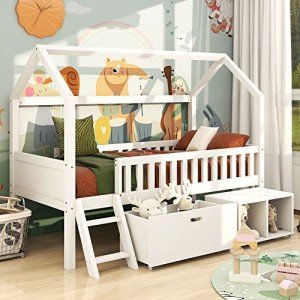Exploring Bunk Beds: A Comprehensive Guide
Bunk beds have long been a staple in children's bedrooms, dorm rooms, and even homes with restricted space. Not only do they offer a useful sleeping option, however they likewise develop an enjoyable and creative environment for children and a great space-saver for adults and households. This post will check out whatever you need to understand about bunk beds, from types and materials to security ideas and buying recommendations.
Tabulation
- Kinds Of Bunk Beds
- Traditional Bunk Beds
- Loft Beds
- Triple Bunk Beds
- L-Shaped Bunk Beds
- Material Options
- Wood
- Metal
- Safety Considerations
- Purchasing Guide
- Frequently asked questions
Types of Bunk Beds
Bunk beds can be found in different styles to suit various needs and choices. Here's a breakdown of the most common types:
Conventional Bunk Beds
Traditional bunks generally include two beds stacked vertically on top of one another. These beds are perfect for brother or sisters sharing a room or for taking full advantage of sleeping space in guest rooms.
Loft Beds
Loft beds stand likewise to traditional bunk beds but do not have a lower sleeping area. Instead, they typically integrate a desk or seating location below, making them a great choice for little spaces needing multifunctionality.
Triple Bunk Beds
Triple bunk beds are developed for three occupants, with beds stacked in a three-tier setup. These are less common but can be an enjoyable option for large families or slumber parties.
L-Shaped Bunk Beds
With one bed placed horizontally and the other vertically, L-shaped bunk beds are typically geared up with extra features such as desks or storage drawers and can match corner areas in a space.
Contrast of Bunk Bed Types
| Bed Type | Ideal Use | Description |
|---|---|---|
| Traditional | Shared bed rooms or guest spaces | 2 beds stacked vertically |
| Loft | Small rooms requiring multi-purpose space | Upper bed with open space underneath |
| Triple | Large families or pajama parties | Three beds stacked vertically |
| L-Shaped | Corner or flexible spaces | A mix of vertical and horizontal beds |
Material Options
Bunk beds are produced from various materials, with wood and metal being the most common. Each material has its benefits and drawbacks.
Wood
- Resilience: Generally robust and can endure years of use.
- Aesthetic Appeal: Offers a classic appearance that can mix with numerous designs.
- Weight Capacity: Typically stronger; can support much heavier weights.
- Downsides: May be more pricey than metal options and can be susceptible to scratches.
Metal
- Sturdiness: Generally light-weight and easy to move but still durable.
- Modern Design: Often comes in sleek designs, making it appealing for modern areas.
- Cost-efficient: Usually less costly than wooden choices.
- Drawbacks: Can be cold to the touch in winters and might not have the same aesthetic appeal for some buyers.
Security Considerations
When it pertains to bunk beds, security can not be overlooked. Here are crucial safety pointers to bear in mind:
- Guardrails: Ensure that the leading bunk has guardrails on both sides to prevent falls.
- Sturdy Construction: Check for a solid develop and strong materials to withstand weight and motion.
- Weight Limit: Adhere to the producer's weight limitation for both the upper and lower bunks.
- Ladder Design: Choose bunks with a safe, easy-to-climb ladder and prevent any sharp edges or rungs.
- Age Restrictions: Most makers suggest that kids under the age of six need to not sleep in the upper bunk.
Buying Guide
When shopping for bunk beds, consider the following elements to discover the very best fit for your requirements:
- Space Availability: Measure the space size and ceiling height, ensuring there is sufficient space for the top bunk.
- Bed Size: Decide in between twin, complete, or bigger sizes based upon your requirements and the size of the space.
- Design Preference: Consider the total design of the bed room to find an appropriate style.
- Relieve of Setup: Look for a bunk bed that is simple to put together.
- Budget: Bunk beds are available in different rate varieties, so figure out a budget before beginning your search.
FAQs
1. What is Bunk Beds For Adults UK suggested age for children to sleep on the top bunk?
Children aged 6 and older are typically suggested to sleep on the top bunk to decrease the danger of falls.
2. How can I make my bunk bed much safer?
To enhance safety, make sure guardrails are effectively set up and check that the bed is put on a flat surface. Additionally, encourage children to use the ladder thoroughly.
3. Can I convert a bunk bed into 2 separate beds?
Lots of bunk beds are designed to be convertible. Check the manufacturer's specs for convertibility functions.
4. What accessories are readily available for bunk beds?
Typical devices consist of beddings, storage drawers, staircases instead of ladders, and tented canopies for an enjoyable visual appeal.
5. How do I keep my bunk bed?
Regular checks for loose screws or structural stability can help ensure safety. Dust the bed frequently and tidy spills promptly to keep the products in good condition.
Bunk beds are flexible and a space-efficient service for various living circumstances, from kids's spaces to visitor accommodations. With numerous styles and materials readily available, prospective purchasers have a wealth of alternatives to think about, making sure a mix of usefulness and aesthetics. By prioritizing security and following the ideas detailed in this guide, individuals can find the ideal bunk bed that suits their space and way of life, all while creating a pleasurable sleeping environment.

